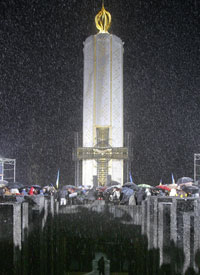They Bear False Witness – How The New York Times Covered Up Mass Murder And Holodomor Genocide
By Jack Allen
The New York Times without fail continues to be there to bear false witness on historic events it seems. Let us look at some examples.
A Lesson For Today –
In his new, highly praised book “The War of the World, “Historian Niall Ferguson writes that no revolution in the history of mankind devoured its children with the same unrestrained appetite as did the Soviet revolution. In his book on the Stalinist purges, Tel Aviv University’s Dr. Igal Halfin writes that Stalinist violence was unique in that it was directed internally.
-
From The New American – November 24, 2008
Ukrainian Genocide: NY Times Still Covering Up
 The New York Times prides itself on being the national “newspaper of record” and still carries its longtime motto, “All the News That’s Fit to Print” in the upper left-hand corner of its front page. If we are to believe the Times’ motto, the week-long Holodomor commemoration didn’t take place, or at least it didn’t qualify as “news.” A search of the Times website — using both visual scan and their own search engine — yielded zero results for current or recent stories.
The New York Times prides itself on being the national “newspaper of record” and still carries its longtime motto, “All the News That’s Fit to Print” in the upper left-hand corner of its front page. If we are to believe the Times’ motto, the week-long Holodomor commemoration didn’t take place, or at least it didn’t qualify as “news.” A search of the Times website — using both visual scan and their own search engine — yielded zero results for current or recent stories.
Using the Times’ search engine and various combinations of “Holodomor,” “Ukraine,” and “Ukrainian famine,” brings up a number of articles, most of which are years or decades old. The most recent entry was a September 6 article covering a visit to Ukraine by Vice President Dick Cheney and his wife. They are shown in a photograph with President Yushchenko and his wife. The caption for the photo reads: “Vice President Cheney, his wife Lynne, left, and Ukrainian President Viktor Yushchenko and his wife at the memorial for the victims of the Holodomor in Kiev, Ukraine, on Friday.” However, there is no explanation of Holodomor for the Times’ readers, 99 percent of whom have never seen or heard the word before.
The photograph accompanies an article entitled, “Cheney Pledges Support for Ukraine,” which reports on the conflict between Russia and Ukraine over Ukraine’s desire to join NATO. However, there is no mention of Holodomor or famine in the article.
There was plenty of Times coverage of other breaking European and World “news” on November 22: an increase in boar hunting in Germany, the semi-retirement of famed French chef Olivier Roellinger, Russian President Medvedev’s trip to Venezuela, an inquiry into the alleged crimes of General Franco in Spain during the 1930s, etc.
The Times neglect of the 75th anniversary of the Holodomor is especially inexcusable, inasmuch as the Times served as an indispensable handmaiden to Stalin as he carried out this horrendous crime against humanity. While the communists carried out the mass annihilation of the Ukrainian farmers, the Timesassured the Western world that all reports of starvation in Ukraine were merely anti-Soviet propaganda. Times reporter Walter Duranty, known as “Stalin’s Apologist,” became a willing tool for the Kremlin and denounced as liars those heroic journalists who dared to report the truth — that Ukrainians were dying by the millions, their bodies filling the streets of many towns and villages. The two most notable of those journalists were Gareth Jones of Wales and Malcolm Muggeridge of England, both of whom are revered in Ukraine and were posthumously awarded the country’s Order of Freedom on November 22 at a ceremony in Westminster.
Jones, who wrote for The Western Mail, The Times [of London], The Manchester Guardian, and other European and American newspapers became a “marked man,” due to his outspoken and fearless exposés of Soviet atrocities, corruption, and failures. In 1935, he was kidnapped and murdered in Mongolia. Although authorities claimed his death was the work of bandits, evidence showed the deed was actually an assassination, carried out by the NKVD, forerunner of the KGB.
Meanwhile, the Times’ Walter Duranty, basking in the glory of a Pulitzer Prize for his sychophantic pro-Stalin reportage, continued to promote the communist line. Without the Times and Duranty providing cover, it would have been politically impossible for President Franklin Roosevelt to grant recognition to the Soviet regime. Four presidents before him and as many Secretaries of State had adamantly refused recognition because of the numerous crimes and atrocities of the communist regime and because of its continuing sponsorship of communist subversive activities within the United States. However, with the Times covering up Stalin’s crimes, including the famine genocide in the Ukraine, Roosevelt was free to arrange official U.S. recognition for the U.S.S.R. on November 16, 1933.
No mea culpa from the Times
The New York Times got away with its perfidy for decades, though this publication and its predecessors (American Opinion and The Review of The News), along with other conservative publications, had been exposing the Times’‘ key role in the Holodomor cover-up for years. Ukrainian groups had been demanding that the Times admit its deception, but to no avail. It was not until 2003, when it was reeling from a scandal involving another of its star reporters, Jayson Blair, that it appeared the Times might be forced to come clean on one of the biggest journalistic crimes of all times.
Under pressure from the Ukrainian community to return Duranty’s ill-gotten Pulitzer to the Pulitzer Prize Board, the Times hired Professor Mark Von Hagen of Columbia University to make an independent assessment of Duranty’s coverage of the Soviet Union during the 1930s. Dr. Von Hagen called Duranty a “disgrace” and criticized his work for its “uncritical acceptance of the Soviet self-justification for its cruel and wasteful regime.” He recommended that the Pulitzer Board take back Duranty’s Pulitzer Prize. Reporting on Von Hagen’s verdict on October 23, 2003, Times writer Jacques Steinberg attempted to give the appearance that the Times had already issued a sufficient pronouncement of public contrition. Steinberg wrote:
That The Times regretted the lapses in Mr. Duranty’s coverage was apparent as early as 1986, in a review of Robert Conquest’s The Harvest of Sorrow: Soviet Collectivization and the Terror-Famine(Oxford University Press). In the review, Craig R. Whitney, who reported for The Times from Moscow from 1977 to 1980, wrote that Mr. Duranty “denied the existence of the famine in his dispatches until it was almost over, despite much evidence to the contrary that was published in his own paper at the time.”
That, apparently, is the Times’ idea of justice: a one-sentence half-apology to make up for reams of propaganda enabling and covering up the murder of millions. Steinberg cited a letter by Arthur Sulzberger, Jr., the publisher of the Times, to the Pulitzer Board. In the letter, Sulzberger referred to Duranty’s reporting merely as “slovenly,” as though he had been careless, rather than deliberately and criminally mendacious. Steinberg then went on to reiterate a theme propounded by Sulzberger, who argued, incredibly, that to strip Duranty and the Times of the Pulitzer would be to engage in Stalinism. Steinberg reported:
Mr. Sulzberger wrote that the newspaper did not have Mr. Duranty’s prize, and thus could not ”return” it. While careful to advise the board that the newspaper would ”respect” its decision on whether to rescind the award, Mr. Sulzberger asked the board to consider two things. First, he wrote, such an action might evoke the ”Stalinist practice to airbrush purged figures out of official records and histories.” He also wrote of his fear that ”the board would be setting a precedent for revisiting its judgments over many decades.”
Bill Keller, the Times’ executive editor repeated the same line, telling Steinberg, “As someone who spent time in the Soviet Union while it still existed, the notion of airbrushing history kind of gives me the creeps.”
Professor Von Hagen responded to the Times’ twisted and deceptive excuse for failing to relinquish the Pulitzer, pointing out the obvious:
Airbrushing was intended to suppress the truth about what was happening under Stalin. The aim of revoking Walter Duranty’s prize is the opposite: to bring greater awareness of the potential long-term damage that his reporting did for our understanding of the Soviet Union.
The Times’ Airbrush Still Working Overtime
The Times ran out the clock on the Duranty-Pulitzer-Holodomor issue in 2003, simply allowing it to die down, apparently confident that only diehard Ukrainian activists would remember. In so doing, the Timescompounded its culpability. Not only is the Times the principal agent in the western media responsible for airbrushing of Stalin’s crimes out of existence, it continues to use the airbrush to prevent any exposure of its past involvement in those deeds. An important case in point is its suppression of a document that has come to be known as the “Gordon Dispatch.” This is a recently released memorandum by George A. Gordon, U.S. Charge d’Affairs in Berlin, Germany, to the U.S. Secretary of State. Gordon said of Duranty, who had just come from the Soviet Union and had stopped by the embassy before going on vacation, “Duranty pointed out that ‘in agreement with The New York Times and the Soviet authorities’ his official dispatches always reflect the official opinion of the Soviet regime and not his own.”
The Times’ defense in recent years — that Duranty pulled the wool over the eyes of the Times — is shown to be likely false. The Gordon Dispatch indicates that it was the Times itself, not merely Duranty, that was responsible for the pro-Stalin, pro-Soviet slant in the Times’ pages. But in the case of Holodomor the Times was guilty of far worse than “slanting” the news; it was a willful collaborator in a “crime of the century,” a willful collaborator in blatant propaganda to cover up that crime. The Times has never mentioned the Gordon Dispatch. According to Ukrainian scholars like Dr. Walter Zaryckyj, an adjunct professor at New York University, the management of the Times has not attempted to atone for paper’s egregious sins in the Holodomor-Duranty case by thoroughly airing the facts, admitting its guilt, publicly apologizing, and unequivocally denouncing Duranty and returning the Pulitzer Prize. “They were allowed to get off in 2003,” on the occasion of the 70th anniversary of Holodomor, Dr. Zaryckyj told The New American, because not enough other members of the media, academia, and the public pressed the issue, when the Times was most vulnerable. “Now it is the 75th anniversary and the Times shows no sign of changing its ways,” he said. “This would have been the perfect time to interview the remaining survivors of the Holodomor and to cover the commemoration [in Kiev, New York City, and elsewhere] and bring world attention to this terrible crime and its victims. The survivors are in their 80s and 90s; five years from now, at the 80th anniversary, most of them will have passed away.”
As far as the Times is concerned, apparently, they will be airbrushed out of history, along with the Holodomor commemoration this year and the original victims of the Holodomor 75 years ago.
For more information, see:
2. From The Federalist – MARCH 24, 2017
How The New York Times Contributed To Ukraine’s ‘Bitter Harvest’ In The 1930s
But this article is not a film review. Rather, it is a peek into how the American mainstream media covered these events some 85 years ago.
There is no consensus among historians as to the extent and causes of the famine. The estimates vary widely between 2.5 and 10 million people. In 2006, the Ukrainian parliament passed a law recognizing the famine as an intentional act of genocide by the Communist regime against the Ukrainian people. The current Russian government argues Communist Joseph Stalin’s disastrous economic policies caused the famine, but rejects the argument that it was a genocide specifically targeting ethnic Ukrainians.
Regardless of that dispute, the famine was definitely a tragedy of enormous proportions. Now, imagine that you live in the United States in the early 1930s and get your news from The New York Times (NYT). What do you know about this tragedy? The short answer is nothing.
The New York Times, Apologist for Communist Murder
The head of the NYT’s Moscow bureau at that time was Walter Duranty, an apologist for Bolshevism. American left-wing intellectuals enthusiastically greeted his dispatches from the Soviet Union. In 1931, Duranty was awarded a Pulitzer Prize for a series of articles in the NYT that covered up Stalinism’s atrocities.
He vociferously denied the existence of the famine in Ukraine, claiming people were “hungry but not starving” and “there is no famine or actual starvation.” Some other Western journalists covering the USSR honestly reported on the famine. One of them was the Manchester Guardian’s Moscow correspondent Gareth Jones, but Duranty tried to discredit Jones’ reports, calling him a liar.
Other Western intellectuals denied the famine in Ukraine in the 1930s, including notably George Bernard Shaw. Some were duped—perhaps willingly—by their KGB handlers who showed them Potemkin’s villages. Duranty’s case had more sinister twists, because we know he was aware of the famine. According to his biography, titled “Stalin’s Apologist,” by Sally J. Taylor, Duranty admitted this when he visited the British embassy in Moscow in June 1932. An embassy official duly recorded his conversation with Duranty to that effect and dispatched his report to the British Foreign Office in London.
Money Hides a Lot of Other People’s Woes
We do not know what drove his desire to spread the fake news, but it may be related to his lifestyle in Russia. Taylor describes it as follows. He was a flamboyant lady’s man enjoying a life of luxury by both Russian and Western standards of that time. He had a researcher, a secretary, a chauffeur, a maid, and a cook.
A surreal aspect of Duranty’s life in Russia was his fondness for fine dining. Here is an excerpt from his description of meals available in a restaurant near his hotel: “caviar; … grilled salmon and roast partridge; … fine Russian cheese, hot-house grapes, old port and older cognac.” The NYT was willing to pay for all these amenities because Duranty managed to get exclusive interviews with Stalin. It was a mutually beneficial arrangement for all parties involved: Stalin received a good publicity in the West, the NYT published exclusive interviews with Stalin, which helped its circulation, while Duranty could lead his glamorous and lavish lifestyle.
It was mutually beneficial for all parties—that is, except for the millions of Ukrainian peasants.
The ending of this saga is rather cynical. In 2003, Ukrainian organizations petitioned the Pulitzer Board to posthumously revoke Duranty’s prize. After deliberation, the board extended its “sympathy to Ukrainians … who still mourn the suffering and deaths brought on by Josef Stalin,” but rejected the symbolic petition, claiming that it could not find “clear and convincing evidence of deliberate deception.”
Duranty and his employer simply spread fake news while millions of people were dying. Their role was akin to that of a musical band that knows people in the next room are tortured and murdered, so they play loud music to drown out their screams, thus preventing outsiders from trying to help the victims.
3. From The Jewish Publication YNet – December 21, 2006
Stalin’s Jews
We mustn’t forget that some of greatest murderers of modern times were Jewish
Here’s a particularly forlorn historical date: Almost 90 years ago, between the 19th and 20th of December 1917, in the midst of the Bolshevik revolution and civil war, Lenin signed a decree calling for the establishment of The All-Russian Extraordinary Commission for Combating Counter-Revolution and Sabotage, also known as Cheka.
Within a short period of time, Cheka became the largest and cruelest state security organization. Its organizational structure was changed every few years, as were its names: From Cheka to GPU, later to NKVD, and later to KGB.
We cannot know with certainty the number of deaths Cheka was responsible for in its various manifestations, but the number is surely at least 20 million, including victims of the forced collectivization, the hunger, large purges, expulsions, banishments, executions, and mass death at Gulags.
Whole population strata were eliminated: Independent farmers, ethnic minorities, members of the bourgeoisie, senior officers, intellectuals, artists, labor movement activists, “opposition members” who were defined completely randomly, and countless members of the Communist party itself.
In his new, highly praised book “The War of the World, “Historian Niall Ferguson writes that no revolution in the history of mankind devoured its children with the same unrestrained appetite as did the Soviet revolution. In his book on the Stalinist purges, Tel Aviv University’s Dr. Igal Halfin writes that Stalinist violence was unique in that it was directed internally.
Lenin, Stalin, and their successors could not have carried out their deeds without wide-scale cooperation of disciplined “terror officials,” cruel interrogators, snitches, executioners, guards, judges, perverts, and many bleeding hearts who were members of the progressive Western Left and were deceived by the Soviet regime of horror and even provided it with a kosher certificate.
All these things are well-known to some extent or another, even though the former Soviet Union’s archives have not yet been fully opened to the public. But who knows about this? Within Russia itself, very few people have been brought to justice for their crimes in the NKVD’s and KGB’s service. The Russian public discourse today completely ignores the question of “How could it have happened to us?” As opposed to Eastern European nations, the Russians did not settle the score with their Stalinist past.
And us, the Jews? An Israeli student finishes high school without ever hearing the name “Genrikh Yagoda,” the greatest Jewish murderer of the 20th Century, the GPU’s deputy commander and the founder and commander of the NKVD. Yagoda diligently implemented Stalin’s collectivization orders and is responsible for the deaths of at least 10 million people. His Jewish deputies established and managed the Gulag system. After Stalin no longer viewed him favorably, Yagoda was demoted and executed, and was replaced as chief hangman in 1936 by Yezhov, the “bloodthirsty dwarf.”
Yezhov was not Jewish but was blessed with an active Jewish wife. In his Book “Stalin: Court of the Red Star”, Jewish historian Sebag Montefiore writes that during the darkest period of terror, when the Communist killing machine worked in full force, Stalin was surrounded by beautiful, young Jewish women.
Stalin’s close associates and loyalists included member of the Central Committee and Politburo Lazar Kaganovich. Montefiore characterizes him as the “first Stalinist” and adds that those starving to death in Ukraine, an unparalleled tragedy in the history of human kind aside from the Nazi horrors and Mao’s terror in China, did not move Kaganovich.
Many Jews sold their soul to the devil of the Communist revolution and have blood on their hands for eternity. We’ll mention just one more: Leonid Reichman, head of the NKVD’s special department and the organization’s chief interrogator, who was a particularly cruel sadist.
In 1934, according to published statistics, 38.5 percent of those holding the most senior posts in the Soviet security apparatuses were of Jewish origin. They too, of course, were gradually eliminated in the next purges. In a fascinating lecture at a Tel Aviv University convention this week, Dr. Halfin described the waves of soviet terror as a “carnival of mass murder,” “fantasy of purges”, and “essianism of evil.” Turns out that Jews too, when they become captivated by messianic ideology, can become great murderers, among the greatest known by modern history.
The Jews active in official communist terror apparatuses (In the Soviet Union and abroad) and who at times led them, did not do this, obviously, as Jews, but rather, as Stalinists, communists, and “Soviet people.” Therefore, we find it easy to ignore their origin and “play dumb”: What do we have to do with them? But let’s not forget them. My own view is different. I find it unacceptable that a person will be considered a member of the Jewish people when he does great things, but not considered part of our people when he does amazingly despicable things.
Even if we deny it, we cannot escape the Jewishness of “our hangmen,” who served the Red Terror with loyalty and dedication from its establishment. After all, others will always remind us of their origin.
Reflecting Beyond the Illusions by The Truth Tale - Now Live At The Following Locations
 |
 |
 |
 |
 |
 |
 |
 |
 |
 |
